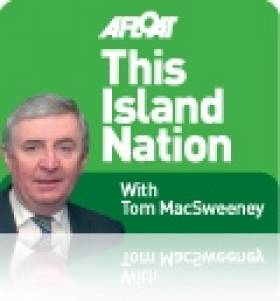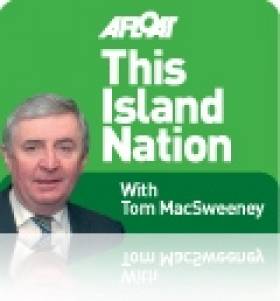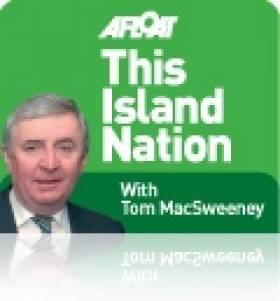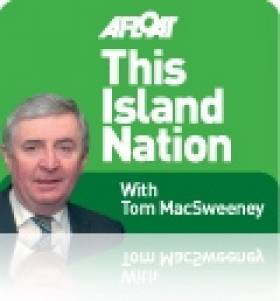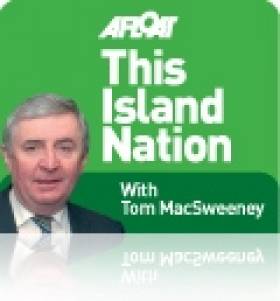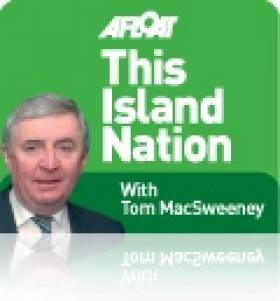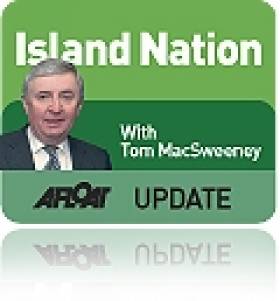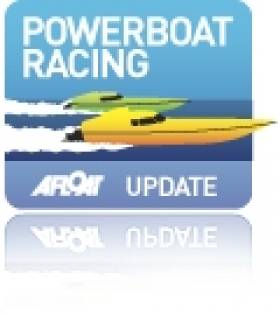Displaying items by tag: Tom MacSweeney
Valentia Radio, Coastguard Equipment & Poor Olympic Coverage
Another attempt is being made by Coast Guard management in Dublin to close the coastal radio stations at Valentia and Malin Head and centralise operations in Dublin. That, the poor quality of television coverage of sailing at the Olympics, the future of the State's national fishing board and the launch of the national maritime plan, are amongst my topics on this week's THIS ISLAND NATION.
RESPECT FOR VALENTIA RADIO
Sailing the West Cork coastline last week Valentia Radio was a welcome companion. I listened to their regular sea area weather forecasts on VHF. They also provide the added service of message 'traffic' for vessels at sea, and advisory warnings about hazards, amongst their service. In addition to VHF Medium Frequency transmission covers a wider maritime area. The voices of the station staff become a familiar and welcome part of one's voyaging. You know they are there, a source of help and support if needed. During the week I heard them involved in search and rescue work, using their local knowledge.
On the North-Western coastline they are partnered by Malin Head Radio, providing a similar service. The staff of both have that vital component not available anywhere else, of local knowledge of their sea areas. The central base is in Dublin where staff can concentrate on the East Coast.
The service works well but high-level Coast Guard officials have been attempting for several years to centralise operations in Dublin and close Valentia and Malin. Previous attempts to do this were defeated when Coast Guard Management proposals were shown not to be in the best public interest.
I feel a sense of anger and annoyance that another attempt is being made to target the stations, emanating from the Department of Transport where a reliable source has given me details of a study on which Minister Leo Varadkar has told officials to prepare proposals which will propose what are termed 'hard decisions' before the Cabinet in October. It appears to me that Coast Guard management want one station, in Dublin, to control all output and, I am told, have repeatedly sought the adjustment of consultant reports to achieve this end. It could be done technically, but would exclude the vital aspect of local sea area knowledge which, in both Valentia and Malin has several times saved lives. It is an approach to safety which is not acceptable, with which there should be no compromise. When then Minister Noel Dempsey attempted to close the helicopter base at Waterford I raised the question – what is the value of one life? I do so again now.
NEW STATION EQUIPMENT
New equipment assigned to upgrade Valentia after the last controversy in 2009 is only due to be installed this month or next, a wait of three years!
New equipment is also being installed at present in Malin. One of the proposals by Coast Guard officials is that if a second station is needed to back-up and support the Dublin central base in case of any fault developing there and threatening a blacking-out coastal communications it should be in Blanchardstown, which just happens to be the Minister's constituency!
A new engine room, new boiler room, new security system, new generator, new operations room, an upgraded transmitter room and a helipad are due for installation in Valentia, so where is the justification for now considering closure – and at a time when other general Coast Guard stations, not radio stations, are and have been built around the country at considerable expense? Where is the logic in this?
THIRD LARGEST COASTAL STATION
Valentia is the third largest coastal marine station in Ireland and the UK. It covers the most turbulent seas in Western Europe and the roughest inland terrain in the country, where it also helps with search and rescue and deals with two-thirds of all 'Mayday' emergency calls around the coast of Ireland.
The station employs 16 people.
At present the Departmental-Coast Guard budget is putting money into a move away from the Eircom fixed line network to an independent contracted microwave network, configured to enable the coast to be covered effectively for marine radio, search and rescue, assistance information by three stations. If this was to be changed to any other configuration, if a one-centre option is chosen in Dublin, there would be an extra cost of around €10m. I have been told. Adding the €5m. already spent on the government decision to improve Valentia and Malin, I wonder what the point of all of this is? Why is Coast Guard management opposed to the costal-based marine radio stations, at the same time as building other Coast Guard bases around the coast. There seems a lack of logic in this approach.
WHAT IS THE VALUE OF A LIFE ?
In safety-at-sea terms the present maritime coastal radio station configuration of Valentia and Malin will always be required, as long-range Medium Frequency communications will stay there, used in addition to VHF to cover wider areas of reception. So even if a one-centre manned set up was followed, with an unmanned centre duplicate in case of Dublin breakdown, there would be two additional unmanned sites at Valentia and Malin to be maintained for long-range communications with attendant costs.
Dublin operates three 8-hour watches while Malin and Valentia have operated a 12-hour shift pattern with the effective saving of 2 staff positions without the requirement for overtime.
Coast Guard officials and the Minister for Transport should back away from proposals to do anything which would reduce the effectiveness of safety at sea.
They would be well advised to do so.
THE FUTURE OF BORD IASCAIGH MHARA
The Chief Executive of the national fisheries board, Bord Iascaigh Mhara, has told me that: "If you look at where the economy is at now, the need for a standalone agency dealing with seafood development makes sense more than at any time in our economic development. The case is stronger today than it has been for many a long time."
Jason Whooley was speaking to me about suggestions that BIM should be abolished and its functions absorbed elsewhere:
"I hope and would expect the review of BIM will come to the conclusion that it is vital to the seafood sector, to the fishing industry, to maintain BIM, but equally it is up to us as an organisation to constantly review ourselves and our services and deliver for the industry. People may see us as a State agency, cushioned from the wider economy and that an organisation needs a jolt. Perhaps that keeps us on our toes, because we are looking at ourselves constantly to improve our services, so I do think BIM has a strong future."
Closing BIM would, in my view, indicate disregard for the role of the marine sphere in government. The opinions of economic consultants are too easily accepted without challenging the damage they could do to the nation's future.
NATIONAL MARINE PLAN
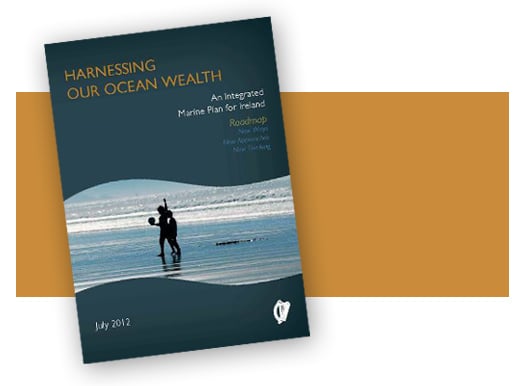
"For too long we have turned our backs on the sea. It's time now to look to our ocean as a national asset, to harness the opportunities for economic recovery. We need to treasure what we have and protect it for future generations. We also need to build on the potential of our ocean wealth and what it can give back to its people. 'Harnessing Our Ocean Wealth,' the title of this plan, puts a structure in place to make that happen".
That was the opinion expressed by Marine Minister Simon Coveney when he launched the national maritime development plan with the Taoiseach in Galway. It proposes that the value of Ireland's ocean wealth could be doubled to 2.4% of GDP and the turnover from our ocean economy be increased to more than €6.4bn by 2020.
It is a long-term outlook, but one to focus on, for seafood, fishing, marine tourism, shipping, oil and gas, renewable ocean energy and new applications for health, medicine and technology. It sets out goals to achieve a thriving maritime economy, healthy ecosystems and to increase the nation's engagement with the sea, focussing on the State creating the right conditions to promote investment and enable growth.
POOR OLYMPIC COVERAGE
I have had quite a few calls and Emails complaining about television coverage of sailing at the Olympics. It has been poor. TV coverage for the Games is provided by t Olympic Broadcast Services (OBS), an agency of the International Olympic Committee and prevents other broadcasters from covering the events. In sailing coverage has not been satisfactory and at times is done on a single camera which is not acceptable at this level of the sport. The IOC has treated sailing badly in television coverage. For a link to all the latest Irish Olympic sailing news click here.
• Email comments, opinions, information to: [email protected]
Follow more marine news and comment on Twitter: @TomMacSweeney
• And on Facebook – THIS ISLAND NATION
Six Thousand Milk Bottles, Barryroe Oil Progress & What Ships Might Look Like in 2020
#thisislandnation – Six thousand milk bottles in Bantry's inner harbour, Barryroe Oil progress, what will ships look like in 2020, disappearing manta rays, a new book scheme for seafarers, emotion in Union Hall, and the future of navigation and visual aids. Read on for this week's Irish and world maritime news developments.
SIX THOUSAND HARBOUR MILK BOTTLES

Diarmaid Murphy Bantry Atlantic Challenge organiser with schoolchildrens images of the event
The schoolchildren of Bantry created an impressive sight in the town's inner harbour where they used 6,000 two-litre milk bottles to build a replica boat for the Atlantic Challenge. Their project underlined the community-wide support for the event which brought hundreds of young sailors to the town for the past week.
Diarmaid Murphy, who led the event's organisational team, told me that the townspeople would like to see the inner harbour developed.
"It has considerable potential for marine leisure. The Challenge is a great event and we have been involved with it since 1988, so there is strong community support for what has been achieved here and the benefits the event, including taking part at home and abroad which has benefited our young people. The event also highlighted the potential of the inner harbour for the town."
The increase of interest in the Bantry Longboats which are used for the event is good to see. There are plans to build a new boat in Tullamore, so perhaps the inland waterways and the Shannon may see a longboat afloat.
BARRYROE OIL PROSPECTS
Last week I wrote about holding a vial of Barryroe Oil in my hand, pictured here and this week Provident Resources confirmed reports that the find has strong prospects. Its announcement will increase interest by the 'majors' in oil production and this is normal at this stage of the find. What benefit will Ireland get from the find? That question has been raised. The present situation is that 25 per cent of the net profits of a developed find, but note that is 'net' after exploration and development costs have been deducted, go to the State. Taxation changes could only be implemented for new investment. Don't expect, at least for the present, that Ireland is going to become as rich a country as Norway!
THE SHIP OF 2020

Technology has made major changes in ship design and operations, but reliance on modern electronic aids and monitoring and control systems will place extra pressure on watchkeepers who will have to avoid complacency in depending upon instrumentation and ensure that the shipboard "man-machine" interface works.
That observation is made in the International Journal of the Nautical Institute, Seaways. The Institute is the professional body for mariners. Rod Short who is Executive Secretary of GlobalMET Limited, writes: "Technological development and its impact on ship operations will continue and probably accelerate. On-board operational roles will have an increased element of systems monitoring and on-board management roles will move towards the building of leadership and teamwork, in particular developing teamwork among multi-cultural crews who may have varying standards of education and training."
He maintains that it is likely that a new ship in the 2015-2020 period will be "extensively automated with extensive use of electro-technology for all critical operations and will be more efficient, more economical and more environmentally friendly."
EMOTION IN UNION HALL

Marine correspondent Tom MacSweeney on right who unveiled the commemoration plaque and officially opened Union Hall Memorial Garden on Sunday July 22nd. On left is Mr Paddy O'Donovan, MC for the occasion and founder of the local community council.
The community of Union Hall have built an impressive memorial to the memory of seafarers at the entrance to the village which was the centre of the Tit Bonhomme trawler tragedy search last January. It is dominated by a 23ft. high anchor.
"On the plaques are recorded the drowning of 99 people, 76 who are named and the majority of whom came from three parishes around Union Hall," community leader Paddy O'Donovan told me. "The other 23 are unknown to us but would have been either Italian or English."
Some lost their lives while earning their living in fishing boats, others drowned in foreign waters in both World Wars, some were strangers whose cargo ships foundered off the coast, others drowned while engaging in watersports. The earliest tragedies recorded date back to February 1874. The memorial has been part-funded by Cork County Council, the rest raised by the community, many of whom I met, including relatives of those who died in the tragedy and the only Egyptian survivor, when I was honoured to unveil the memorial.
BOOK SCHEME FOR SEAFARERS
The Marine Society of the UK has launched a new crew book service for seafarers and ship operators. Books@Sea will equip ships with new paperbacks for seafarers. It is a new crew library service built on the experience gained by the Marine Society over many years.
"It offers a means of relaxation for seafarers and is a positive contribution to a safety culture at sea," said Captain Andy Winbow, Assistant Secretary of the International Maritime Organisation, at the launching of the service in London.
More information on: www.marine-society.org
E-NAVIGATION DEVELOPMENT
The Commissioners of Irish Lights will be working with user groups and stakeholders in the coming year to define how e-Navigation should be implemented in Ireland.
Captain Robert McCabe, Acting Head of Marine at CIL, believes that the role of visual Aids to Navigation will "undoubtedly decrease and radio navigation will come to the fore." In The Beam magazine of the Commissioners he indicates that 'Visual AtoN will still have a role 'for spatial awareness and the marking of some dangers' but they will reduce in both number and range.
"The risks of 'heads down' navigation (looking at the screen) are obvious. The challenge is to significantly improve 'heads up' navigation (looking out the window) and to continue to engage navigators with their surroundings while taking advantage of improved positioning, communications and charting. In the coming year we will work closely with user groups and stakeholders to define how e-Navigation should be implemented in Ireland and how we can maximise the benefit."
GENTLE GIANTS UNDER THREAT
The ocean's "gentle giants" as they are known, manta rays, are under threat because of increased fishing in Asian and South American waters to catch and kill them for their gills, used in soups and other dishes in Asia and traditional Chinese medicine.
The rays are pulled from the ocean, using either fine gill nets or spears. They are easy targets as they move slowly through the water. The United Nations Food and Agriculture Organisation says catches have quadrupled and the International Conservation for Nature has now classified the species as 'vulnerable.' They are in particular danger because they produce few young.
You can follow me for more marine news and comment on Afloat's Twitter and Twitter: @TomMacSweeney
And on Facebook – Afloat magazine and This Island Nation
#island nation – Barryoe Oil from West Cork; can Irish civil servants co-operate in the interest of the marine sphere; more signs of the difficult economic times with sailing cutbacks; deciding whether the white shark should continue to be protected; Ireland winds the British School Sailing Championships; consumers are using ecolabels to decide their fish-buying habits, the Atlantic Challenge and the continuing mystery of the Lusitania, are my topics this week.
OIL FROM WEST CORK OFFERS PROSPECTS!
I held a phial containing Barryroe Oil in my hand on Saturday, the first time I have seen an example of this discovery off West Cork.

John O'Sullivan of Providence Resources
John O'Sullivan, Technical Director of Providence Resources, was outlining the find at the Glandore Maritime Summer School which was discussing Ireland's Ocean Wealth.
He said the oil is of good quality and during the initial testing had flowed at 1,500 barrels a day. The find has great potential, he said and told the audience that the company was considering Irish facilities to bring it ashore and there will be drilling in other areas, including off Spanish Point.
It was an encouraging description of the resources off our coast.
CAN CIVIL SERVANTS CO-OPERATE IN MARITIME DEVELOPMENT?
I chaired the Saturday afternoon session at the summer school where fundamental questions were raised about government and civil service commitment to the marine sphere. The Officer Commanding the Naval Service, Mark Mellett, a courageous speaker, made the case that the Navy can contribute a wider role to the national economy than just that of a defence force. Micheal O Cinneide, formerly with the Marine Institute and now with the Environmental Protection Agency highlighted lack of co-ordinated decision-making amongst Government Departments.

Glandore Summer School 2012
The level of actual sea-going experience amongst civil servants forming the government's Marine Co-ordinating Group which is drawing up the national maritime development plan was discussed. Many people at Glandore had never heard of this Group, though the plan they have been preparing is due to be launched later this month. The issue of whether the nine government departments on the Group, competing against each other for scarce resources, can co-operate in the interest of advancing the marine sphere as a major national economic resource, was raised. The school was told that top civil servants regularly go to the high-powered Harvard Business School in the USA to hone their skills and are top of the class in administration, but regularly fail to show that they can co-operate or work together. An interesting reflection!
Marine Minister Simon Coveney maintained that they can and are co-operating and that the plan will point to an exciting future for the marine sphere, establishing it as a major economic sector. He said there had been strong public interest in making submissions.
CALVES CUTBACKS
Alan Dwyer the Commodore of Schull Harbour Sailing Club in West Cork has been telling me of another sign of the difficult economic times - Calves Week will be a different event this year.
"We have made major changes to what was an event which had grown with time and tradition to lasting almost two weeks. That grew with the holiday season in Schull but as people have come under more time and economic pressures, those who took part told us they wanted a shorter and less expensive alternative."
The club has responded by cutting the event back to a four-day Calves Week Championships which will start on Tuesday, August 7 and run until Friday, August 10. Schull will have a sailing festival with the village decorated in a maritime theme by local businesses and events for all the family. The traditional regattas in Baltimore, Crookhaven and Schull will continue as stand-alone events with their own courses and prizegivings, organised by the local clubs.
Schull Harbour SC was founded in 1977 as a summer sailing club and from its inception has actively promoted leisure and competitive sailing in the West Cork harbour. The first commodore was Billy Pope who had sailed in the area from the fifties in his yacht Pendua.
SCHULL REVENGE IN BRITAIN
The Fastnet International Schools Regatta is being revived in Schull this month following the hosting of the World Team Racing Championship there last year and will be held from Monday to Thursday next week, July 23-26. Gold Fleet Racing will take place in the TR3.6 dinghies which were designed and built for the world championships. Handicap Racing will take place in both silver and bronze fleets with class racing where sufficient entries are received.
The success of what has been achieved by the concentration which Schull Community College has placed on sailing as part of the sports curriculum is shown by the College winning the British Schools Dinghy Team Racing Championships for the second time in 3 years. Racing was at Bough Beech Reservoir in Kent. The students of Schull Community College beat Magdalen College, Oxford, by 2 races to nil in the final. The Schull team crews were: Oisin O'Driscoll/Katie Moynihan; Connor Millar/Ellen O'Regan; Fionn Lyden/Mark Hassett.
BANTRY CHALLENGE
Next week also, this time in Bantry, young sailors from 16 nations will be taking part in the Atlantic Challenge. Competitions involving sailing and rowing the Bantry Longboats which are replicas of the Wolfe Tone Expedition and the French Armada dating back to 1796. There will also be seafaring competitions.
I once sailed in one of the boats and, as they are also rowed, they do not have the traditional keel which keeps sailing vessels upright, so they are balanced by the weight and positioning of the crew. That keeps you on your toes, but it is exhilarating and challenging sailing.
REVIEWING PROTECTION OF WHITE SHARKS
Continuing the protection of white sharks is being questioned in Western Australia after a fifth fatal attack on humans since September of last year. The State's Fisheries Minister, Norman Moore, said that the level of attacks on humans by white sharks was higher there than documented anywhere else in the world and action would have to be taken to deal with the situation.
White sharks have been a protected species for more than a decade, since the International Union for Conservation of Nature identified them as vulnerable. The Federal Government's White Shark Recovery Plan was released in 2002 and reviewed in 2008. That review found insufficient evidence to confirm an increase in the species. He wants the Federal Government to discuss the research data on which the protection of these sharks is being maintained and whether that status should be reviewed.
BUYING FISH BY LABEL
Consumers around the world, particularly in Northern Europe, are using ecolabels to find out if fish they buy come from sustainable stocks, according to the Marine Stewardship Council. It commissioned an independent study which found that label recognition was highest in Germany and lowest in France.
LUSITANIA MYSTERY CONTINUES
The underwater footage of the Lusitania wreck shown on the National Geographic Channel was very impressive and concluded with a US government weapons research centre testing the theories about a second explosion after the liner had been torpedoed.
The conclusion was that this was a boiler explosion and that only the German U-boat torpedo sank her. Greg Bemis who owns the wreck disagreed and says he will continue to explore the second blast theory.
You can follow me for more marine news and comment on Twitter: @TomMacSweeney
And on Facebook – THIS ISLAND NATION page
https://www.facebook.com/pages/This-Island-Nation/143538032444882
#islandnation – A great maritime show in Galway, controversy after the Round Ireland in Wicklow, honouring the community of Union Hall, tougher inspection of cruise ships visiting Irish ports, hogging moorings on the inland waterways, aliens in the Royal Canal, a new fleet of currachs in Killybegs, the wearing of lifejackets and Cork Week, seafood and seaweed sausage and a Howth Lifeboat retirement - it is a busy time on the marine scene!
HONOURING THE PEOPLE OF UNION HALL
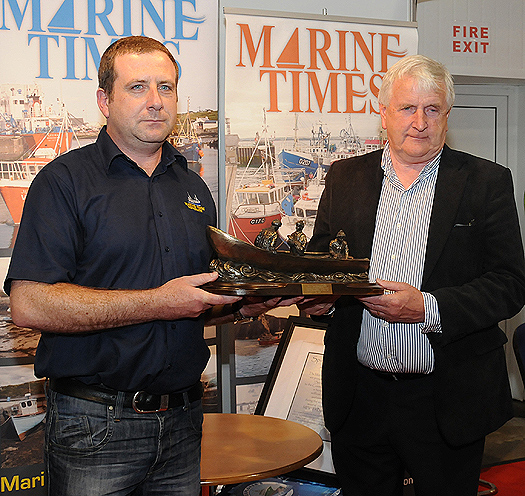
You could feel emotion in the fish auction hall on the quayside in Killybegs when the dark days of last January were recalled on Friday morning as Bill Deasy, one of the West Cork fishing village's community leaders, stood in front of compatriots from coastal areas all around Ireland. A few tears were quietly shed as the tragedy of the Tit Bonhomme trawler was recalled, but shining above it all was the memory of how the people of Union Hall rallied around those families from Ireland and Egypt in the search for bodies and showed what a maritime community can do.
The occasion was the presentation of the first 'Spirit of the Sea' Award, recognition of the "inspiration and selfless commitment" of the people of Union Hall in the dark days of the Tit Bonhomme trawler last January.
"Grief and sadness was palpable across the country with the tragedy resonating amongst the coastal communities. The inspiration provided by the people of Union Hall in pursuing the search to a successful conclusion was something that we should all be proud of," said the Editor of the national fishing paper, The Marine Times, when he presented the award to Bill Deasy at the Fish Ireland Exhibition who accepted it on behalf of Union Hall.
"The dedication and compassion of the community inspired the creation of the award for which there was unanimous support from fishing ports all over Ireland," said Mark McCarthy. "It is not only dedicated to them but was inspired by them."
Later this month the Union Hall community are to unveil their own memorial in the village to all who have died at sea.
The concept of national awards in the maritime sphere is, I think, worth pursuing to raise public awareness of marine matters. It was good to see the Union Hall community honoured.
A GREAT SHOW IN GALWAY
The people of Galway have once again shown that their city deserves to be a maritime capital. It would have been hard to imagine that they could surpass what they did the last time the Volvo Ocean Race called, but they did. Despite the bad weather which has dogged Ireland this summer 20,000 people was the number put on those who, in the early hours of the morning, welcomed the Volvo Race fleet. It can be truly said that no other city has shown the backing to this event as has the City of the Tribes.
I am delighted that the mainstream general media has at last recognised Damian Foxall from Kerry as an international sporting icon. After fifteen years and four attempts in the Volvo Race, he has earned the overall winners' podium on the crew of the French yacht, Groupama. It was appropriate that his colleagues stood back to let him take the plaudits from the attendance in Galway.
Let us also not forget our other Irish sailing icon, Justin Slattery from Cork, also an overall Volvo winner as bowman on the Dutch entry ABN Amro One which was the overall victor in 2005-2006.
It is time that there was public appreciation in Ireland of these sailing stars who are far more deserving, in my view, than the approbation given to overseas footballers' and who are also far more approachable, courteous and personable. Well done to Damian, to Justin, to all the sailors in the Volvo Race and all those behind the great show in Galway.
INLAND WATERWAYS

Driving back from Killybegs I stopped in Carrick-on-Shannon on Saturday afternoon, which was a revelation of how busy the maritime sphere can be inland. It was throbbing, busy, boats moving, lots of people around strolling along the riverbank on what was, for once, a nice sunny afternoon which would make you want to be on the water. It was good to see. Carrick-on-Shannon is a town which has paid attention to its maritime resources and is benefiting from that.
I hired a boat a few years ago there for a week on the inland waterways and thoroughly enjoyed. In most weather conditions you could move and the riverside towns and villages were always welcoming.
However, sometimes boat people are not welcoming to others and this is a disappointment. Waterways Ireland is getting tougher about "mooring hoggers" who have blocked up harbours and denied visitors access. It has been successful in prosecutions for breaches of a 48-hour mooring Bye-law in Lough Erne. I was told in Carrick-on-Shannon of instances where visiting boats at different locations along the waterways had alleged they had been denied the facility of mooring alongside boats already in harbour and that some had thereby felt forced back out into unsuitable weather. That this should happen is appalling and creates a potentially dangerous situation.
ROUND IRELAND PROTEST
Galway added to its sailing prowess when the Clifden Boat Club was declared overall winner of the Round Ireland Race in which members had sailed a Ker 39, Inis Mor. With the students of NUI Galway winning Class 1 that made a dual success for the West in the week in which Galway has taken centre place in the sailing world.
There is controversy about other aspects of the race, though it will not affect the overall winners. This will have to be resolved at a hearing after the organising race committee from Wicklow Sailing Club lodged a protest against Green Dragon, the former Irish entry in the Volvo Race, under sailing's Rule 47. This requires a yacht to start and finish with the same number of crew.
The race committee told me that the listed Skipper, well-known sailor Enda O'Coineen left the yacht at the Fastnet. It was first back to Wicklow, followed by the Dutch entry Tonnerre de Breskens, sailed by Piet Vroon who was defending his title. Explanations given by Green Dragon for the departure of the Skipper during racing didn't satisfy the race committee. There are provisions for a crew member to leave and I am told that Enda O'Coineen has indicated he will be defending his situation. A protest date has not yet been set.
ANOTHER SUCCESS FOR BARRY
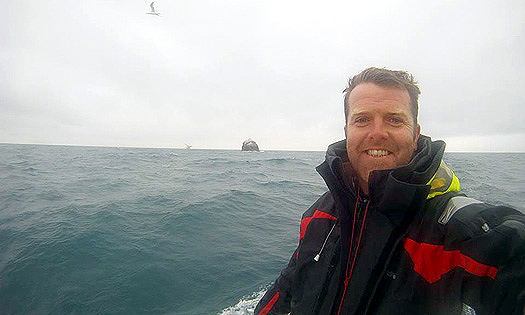
Amidst all the coverage of the Volvo Race in Galway, another great achievement by Cobh sailor Barry Hurley did not get a lot of attention. Sailing alone in his JOD 35 Dinah, the accomplished single-hander won the first Round Rockall race from Galway. It was a tough 750-mile voyage to be on your own. Barry who takes pride in his native 'Holy Ground' in Cork Harbour sent this self-portrait from Dinah having rounded Rockall. Two years ago he won the transAtlantic OSTAR Race to America.
BLESSING THE CURRACHS IN KILLYBEGS
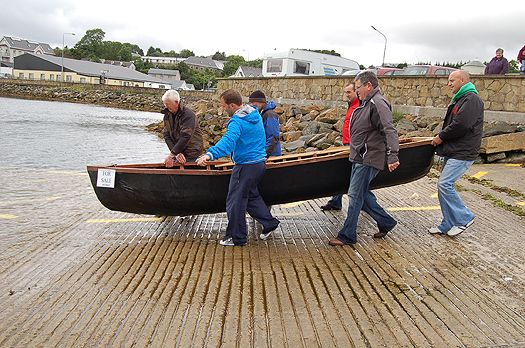
The most unusual thing I have been asked to do as a Marine Correspondent is to bless boats! This happened at Killybegs on Saturday afternoon when I was handed a bottle of holy water to bless the boats and wish them a safe future as the fleet was launched from the pier in the fishing town. Built in a community project they are very impressive. As I have been writing in this column, the currach is a superbly designed boat. Neily Gallagher who ran the project told me all about it and I also met the great builder and expert on currachs Owny Diver from Gola Island. A lovely occasion to be involved with.
CRUISE OPERATORS CONSIDER IRISH THREAT
Cruise ship visits are an important economic tourism boost to several ports including Cork, but there are indications that operating companies are examining what effects will result from the statement by the Maritime Safety Office that safety checks on their vessels are to be intensified when they call to Irish ports. This is in the wake of the Costa Concordia disaster. According to reports this week checks of safety and crew ability to handle evacuation will be stepped up. They are already regarded as quite tough here. While there should be no compromise on safety, it is to be hoped that there will not be an over-zealous approach which might damage this valuable shipping business.
An inquiry report into the Costa Concordia disaster is due in the middle of this month. There are unconfirmed reports about equipment not being in proper working order aboard the ship, including the 'black box' which should record conservations amongst officers on the bridge and navigational equipment, as well as suggestions that safety doors were left open rather than being closed at sea. The company has denied the Italian newspaper reports, so the release of the investigation report will be interesting to see.
WEARING LIFEJACKETS
As I watched the photographs of trawlers which had sunk with loss of life, washed up on rocks, or just disappeared, I looked at the faces of others watching the screen display, fishermen who go to sea in this most dangerous and challenging of occupations and women and children of fishing families. It was a reminder that the sea can never be taken casually.
John Leech Chief Executive of the Irish Water Safety Association was making a compelling, thought-provoking presentation at the FISH IRELAND exhibition in Killybegs where I interviewed him as part of a public series. He showed slides of the various fishing accidents and spoke about the subsequent loss of life over recent years. Very direct in pointing out to fishermen and their families the tragic consequences of not wearing lifejackets, he stressed how much more user-friendly they are these days. John's message, for all leisure boat users as well as fishermen is - be safe on the water - think of the family and wear a lifejacket. There are reminders of fishing tragedies all over the coast.
CORK WEEK
The overall entry for Cork Week is smaller than in previous years, 105 boats at the time of writing, an indicator of the economic times. The RCYC organisers have responded with some new courses, a new layout for the Race Village and say the entry may be smaller but the quality is good.
Next Friday will provide a nice public spectator opportunity for the "Cobh race" as it is known during Cork Week. All classes taking part will be combined to race around a turning mark off Cobh which, allowing always for the weather, will be a good opportunity for spectators to see sail racing and, hopefully, lots of spinnakers being raised to add colour to the spectacle.
MY FIRST SEAFOOD SAUSAGE
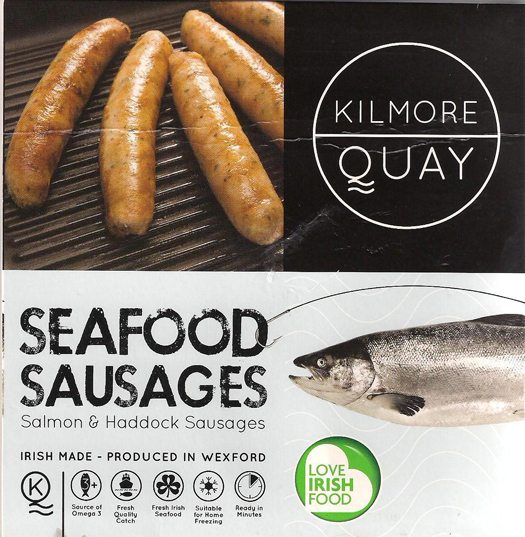
This week I ate my first seafood sausages of salmon and haddock which came from Kilmore Quay and were bought on their first delivery to a Cork supermarket! Very tasty. Four big sausages for €4.99 and well worth the price. I am told, if ever I get the chance, to try seaweed sausages that are
"amazing" and are in some shops, though I haven't seen them yet.
HOWTH RNLI RETIREMENT
The maritime community in Howth have paid tribute to George Duffy who has retired after 44 years with the RNLI where he was Mechanic for 25 years and also had been Deputy Coxswain to his younger brother, Robert. There is a strong family involvement with the Howth lifeboat. His youngest brother, Michael, is also an RNLI volunteer.
SCOTLAND SHOWING THE WAY
The UK Government has done an about-turn on its decision not to provide funding for an emergency towing vessel in Scotland after pressure from the Scottish Parliament. Under new arrangements a Scottish ETV will work with the UK Coastguard. The Scottish are really pushing forward the maritime aspect of their governmental responsibilities. They have also made big advances in getting back some of their fisheries controls. The provision of emergency towing vessel facilities in Ireland does not bear comparison, nor does the approach to protecting and developing our own fisheries. The UK Government in London may be taking an example from the Scottish in maritime initiatives. It has pressured the EU Commission into examining funding support for the development of British inland waterways for use by commercial freight traffic.
ALIENS ON THE ROYAL CANAL
Inland Fisheries Ireland has removed a turtle from the Royal Canal near Mullingar in County Westmeath. It seems the 30 cm. red-eared slider turtle may have been around for some time and been a nuisance to anglers by persistently taking their bait! This species is native to southern USA waters apparently and how it got to Mullingar is unknown so far, but there is suspicion that it may have become an unwanted pet that was dumped.
IFI is monitoring the stretch of the canal involved, though it is hoped this may be a one-off instance. If not there could be other repercussions for marine life there. The turtle has been removed to "another suitable location."
YOUTH SAILING AND ATLANTIC CHALLENGE
After the Volvo and Cork Week, young sailors will dominate the sport at Dun Laoghaire from July 12-21 at the International Sailing Federation's Youth World Championships and the Fastnet International Schools' Regatta will follow at Schull in West Cork from July 23 to 26.
Also in West Cork young people will take centre stage in Bantry from July 21-29 at the Atlantic Challenge.
You can follow me for more marine news and comment on Twitter: @TomMacSweeney
And on Facebook – THIS ISLAND NATION page
https://www.facebook.com/pages/This-Island-Nation/143538032444882
The Pace Picks Up in Galway
#islandnation – THIS WEEK : Smelly humans, the pace picks up in Galway, pirates in Baltimore, the response of fishermen to the condescending RNLI and a Cork beauty are amongst my topics this week, read on .....
GALWAY PACE PICKS UP
There is an increasing buzz of excitement in Galway where the pace has picked up notably this week with work well underway on constructing the Volvo Ocean Race Village and increasing hope that Damian Foxall could be representing Ireland on the overall Volvo winners' podium in the City of the Tribes. It is still disappointing that the general media is not focussing attention on Ireland's two top international sailors in the race - Damian from Kerry and a member of Kinsale Yacht Club who is aboard the French entry Groupama and Justin Slattery from Cork who is with Abu Dhabi Ocean Racing.
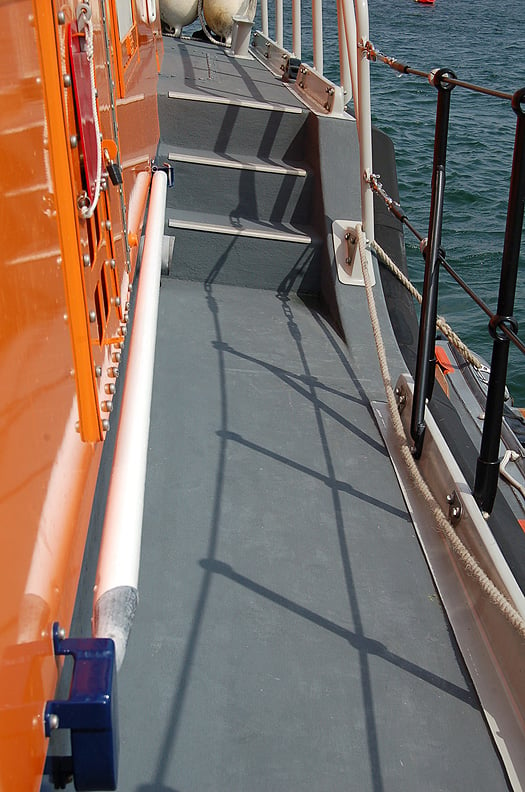
The boat hook on Achill lifeboat
FISHERMEN TELL OFF THE RNLI
Dick Robinson, former lifeboat crewman from Valentia Island and author of several books about the lifeboat service, has written to me about my visit to the Achill Island lifeboat when I said I had learned that the two boat hooks on modern lifeboats are the only items remains as a tradition from the past."
Dick confirms that this is a reminder of the rowing lifeboat days:
"The RNLI at that time issued a rather condescending circular that white oars were to be used to starboard and blue to port, as 'the orthodox terms, starboard and port are rarely used in lifeboat work since many lifeboatmen are unaccustomed to nautical phraseology.' The Penlee crew reversed the placings as a protest against the tone of that circular.
"The orders from the Coxswain would be 'Forward the white, Back the blue' or reverse as appropriate. The boats would have no steerage way working in close, so the rudder would not be effective and so oars had to be worked all the time. The oars were the subject of considerable research as oars breaking during beaching or launching operations could be fatal. In 1866 trials were carried out involving 38 different types of wood. The best oars were found to be made from young trees in Norwegian and Baltic Wood, followed by oars made from planks of the same woods. Oregon Pine was also good. A balance had to be struck between oars which would break under ordinary conditions and ones which would not break if the lifeboat struck bottom in shallow waters and thereby might capsize her. Later oars were balanced with lead inside."
Thanks Dick for this information on a fascinating topic.
PIRATES IN BALTIMORE
The sacking of Baltimore village, a very popular sailing destination in West Cork, is the topic of a 'PIRATE SEMINAR' – an unusual addition to the list of maritime events this summer. It will be held next weekend, starting on Friday night, June 29 and running until Sunday, July 1, including events for all the family.
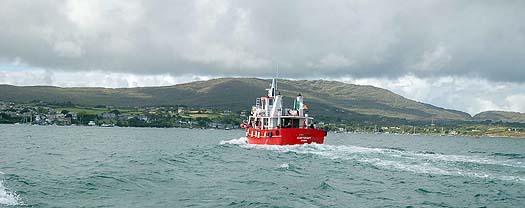
The Schull – Baltimore – Cape Clear ferry departs Baltimore
Des Ekin, Assistant Editor with the Sunday World and author of the book – 'The Stolen Village' will discuss the 'Sack of Baltimore' in 1631 when inhabitants were taken off to slavery in Algiers. Connie Kelleher, Underwater Archaeologist with the Dept. of the Arts, Heritage and the Gaeltacht's Underwater Unit will discuss piracy in southwest Ireland in the seventeenth century.
New to Baltimore is a permanent 'piratical exhibition' at Dún na Séad castle, with details of the raid on the village and copies of rare graphics from the seventeenth century depicting the story of the Baltimore captives who were taken into a life of slavery. Details are also shown of the activities of the O'Driscoll clan and their notorious involvement with the men of Waterford during the middle ages. A depiction of Thomas Crooke, the English 'pirate/planter' is also featured. An accompanying feature of the exhibition is a new book by Bernie McCarthy called 'Pirates of Baltimore,' containing images of lifestyles and events associated with the piratical history of the village. Did you ever imagine the respectable Baltimore of today to have such a history!
The exhibition is open daily 11am – 6 pm.
THE BEAUTY OF TRADITION
There is a great beauty in traditional boats and the one pictured here, the Peel Castle, was for me the star of this year's Crosshaven Traditional Boats Gathering. She is owned by Graham Bailey and deservedly won the top prize at the event. A fishing lugger she was built back in 1929 at Porthleven in Cornwall, carvel, pitch pine planking on oak frames and her original engine power was 2 x 25 hp Alphas - currently 120hp Ford D series.
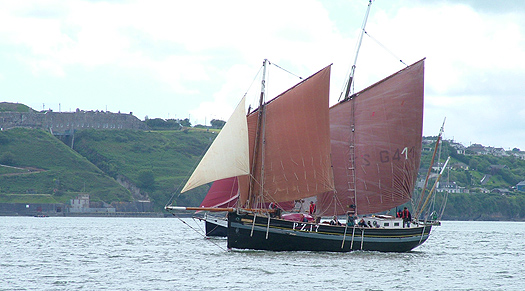
The Peel Caslte racing off Crosshaven
She was registered PZ17 at Penzance, later BM17 Brixham, Devon. She also fished out of Fleetwood from1968 and finished fishing in 1977 when she was de-registered. Re-registered in Skibbereen in 2008, she has sailed extensively in European waters. Restoration work was done at Hegarty's Old Court Boatyard and is impressive. Graham, a shipwright, also restored her internally. Visitors aboard were very impressed.
GASSY HUMANS!
Human-produced gas emissions are a significant cause of ocean warming!
Average ocean temperatures have been rising by 0.045 degrees per decade for the past half-century and natural fluctuations alone "do not explain warming in the upper layers of the planet's oceans," according to the Lawrence Livermore National USA National Laboratory. "Human greenhouse gas emissions are an added ingredient and strengthen the conclusion that most of the global ocean warming over the past 50 years is attributable to human activities," according to Livermore climate scientist Peter Gleckler.
The Californian Laboratory which made these findings in a desktop computer modelling study of the Atlantic and Pacific Oceans also researches protection against weapons of mass destruction!
To Email your comments to THIS ISLAND NATION: [email protected]
Follow Tom MacSweeney on Twitter @TomMacSweeney and on Facebook
In this week's column: Safety in sailing; ocean wealth in Galway; the US Navy going green; increased shipping in the Arctic Circle; Denis Noonan and the Round Ireland Race; Australia's world ocean reserve and the UK Coastguard suggests offshore sailors use satellite phones.
OCEAN WEALTH IN GALWAY
Rain was lashing against the bridge windows of the Irish Lights' vessel Granuaile in Galway Docks, the wind was howling. Most definitely, it was not a nice day to be on the water when I told the audience listening to me that we Irish people are fortunate to live on an island. I was launching the Ocean Wealth Showcase with Yvonne Shields, Chief Executive of the Commissioners of Irish Lights. It will take place at the Volvo Ocean Race Festival from June 30 to July 8 and will be well worth a visit.
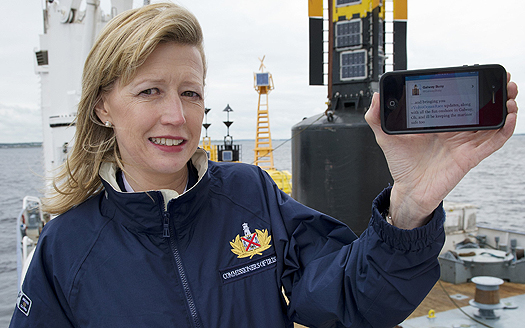
Yvonne Shileds with the new Twitter buoy off Galway yesterday
Driving into Galway you can see that the city has embraced the Volvo Race and, talking to that great member of Galway Bay Sailing Club and one of the men whose determination brought the race to the City of the Tribes, John Killeen, we agreed that the overall result will be decided in the city. Eamonn Conneely, who sailed Patches to international success and Enda O'Coineen, were the other members of the trio which led the Galway Volvo campaign. Well done to them and all those involved, including hundreds of volunteers, who have established Galway on the world maritime map.
State agencies and commercial companies and organisations have put together the Ocean Wealth Showcase. Throughout the week there will be a wide range of exhibits demonstrating the scale and diversity of Ireland's ocean resources and their economic, social and environmental value to our island nation. In addition there will be a range of business and family events throughout the week.
It was a pleasure to launch the Showcase and to see how much commitment is being given to it.
The launch coincided with the placing of the Galway 'Twitter' Buoy in the Bay which will Tweet information about the Showcase as well as navigation and metocean information about the Volvo Race and Galway Bay. Look it up on www.twitter.com/GalwayBuoy.
TO SAIL OR NOT TO SAIL
There has been a lot of heavy weather around to test the ability of sailors. Not surprisingly, the issue of how safe is the sport and in what state of bad weather racing should be held, has arisen. I did not finish the first race of the Union Chandlery evening league at the RCYC in Crosshaven due to prevailing heavy weather conditions. The forecast was not encouraging but it seemed a reasonable assumption that the race could be held before a strong front arrived. Shortly after it began, though, the very heavy weather arrived. Wind strength was 27 knots, with gusts of 34 according to meteorological reports recorded at Roche's Point. With a reef in the main, two rolls of the headsail taken in on the furling jib, the boat still taking a pounding while reaching speeds of 8 to 9 knots at times, I decided it was better and safer for my 33ft. Sigma and crew not to continue to race and withdrew. In Class 3 in which I was competing, six of the seven boats taking part retired. Class 1 and 2 boats raced on to their finish.
Afterwards there was quite a bit of discussion about the conditions. Views ranged from those who thought them too heavy, to others exhilarated by what they had encountered, underlining that individual views differ about conditions. For those who ask when racing should or should not be held, the decision on whether or not to race and responsibility for it must be taken by the Skipper. Clubs will provide racing, but do state in their regulations that the decision to sail is that of the Skipper. Therefore the crew who go with him or her are presumed to support that decision. Insurance companies are careful about stating their position, but my understanding is that they regard the responsible person as the one who has insured the boat.
Experience of heavy weather is necessary for sailors because weather patterns can change quickly in these waters. Leisure sailing, to which I am referring in this regard, is different to professional racing such as the Volvo Round the World Race where conditions far different to club racing are experienced and sailors must be capable of dealing with them.
The second race of the league was cancelled this week because of the very heavy weather conditions, quite rightly in my view. I would be interested to hear views from readers.
NICE DOCKS IN GALWAY
I like the comment which Galway Harbour Master Capt.Brian Sheridan made to me about the new view the people of Galway have of the city docks:
"The people of Galway no longer refer to the 'docks' as a dirty, disliked place. It is now 'the harbour,' a positive part of the life of the city and it will be even more important, because the West of Ireland deserves to have a strong, vibrant port as a major economic contributor to the city and the western region."
He is one of the driving forces in the successful staging of the race. It is on his shoulders that arrangements for the berthing of the race fleet and visitors falls.
DENNIS NOONAN, WICKLOW AND THE ROUND IRELAND
"There were those who thought we wouldn't make it, but again we have," Dennis Noonan told me from Wicklow Sailing Club in that quiet but determined voice of his when we talked about this year's Round Ireland Race which will start on Sunday, June 24 and for which there are 38 entries as I write. The number includes more British than Irish. There are 18 from the UK, just 12 from Ireland, with several other countries represented. Dennis is a legend who has devoted huge energy to the staging of the Round Ireland. 'Fair Sailing' to all competitors.
I hear indications that Green Dragon, Ireland's former Volvo entry may be returning to racing and participate, with plans to use it for offshore training.
US NAVY GOING GREEN
The United States Navy is making a move towards going 'green'. In exercises off the coast of Hawaii next month five warships are to make Stateside maritime history when they become the first to use biofuels to power their turbines, as well as jets flying off a carrier's deck and helicopters hovering overhead. The flotilla will be powered by a mixture of cooking grease and algae oil of which 3,400 tonnes was loaded aboard the Naval fleet oiler, Henry J.Kaiser, this week to supply the ships. This is part of the U.S. Navy's efforts to move away from dependence on petroleum.
AUSTRALIA HAS WORLD'S LARGEST MARINE RESERVE
Australia has created the world's largest network of marine reserves where it will restrict fishing as well as oil and gas exploration to safeguard the environment and access to food the government says. The area covers 1.2 million square miles of ocean, a third of the island continent's territorial waters, which sustain more than 4,000 species of fish.
The environmental group WWF has welcomed the development but the government's conservative opposition has vowed to review the boundaries if it gets into power at elections next year, an outcome that opinion polls indicate is likely!
"I am instinctively against anything that damages the rights of recreational fishing and anything that will further damage the commercial fishing industry and tourism," opposition leader Tony Abbott said. {youtube}KPLvgZa3ltA{/youtube}
MORE SHIPPING USE OF THE ARCTIC
Shipping cargoes moving through Arctic waters are set to rise to their highest this year as companies use the route to cut journey times and fuel usage compared with Suez Canal shipments.
Nordic Bulk Carriers A/S plans to transport about six to eight 70,000 metric-ton shipments of iron ore to China from the Russian port of Murmansk starting next month. Using the Northern Sea Route for the journey instead of the canal is saving the company 1,000 tons of fuel, or $650,000 per journey.
SATELLITE PHONES OFFSHORE
It was interesting to see what appears to be a change of approach by the UK Coastguard this week when it suggested that offshore sailors should carry a satellite phone for emergencies,
Following the helicopter rescue of a solo sailor whose 22ft boat had been knocked flat repeatedly in Force 9 conditions, Falmouth coastguard issued a statement: "For offshore voyages leisure sailors are recommended to carry a satellite form of communication."
"It makes life easier for us if we can be in direct touch, because then we can establish what the problem is," said James Instance, Watch Manager at MRCC Falmouth. "An EPIRB is fantastic, but although it indicates position it doesn't say what kind of distress it is."
To Email your comments to THIS ISLAND NATION: [email protected]
Follow Tom MacSweeney on Twitter @TomMacSweeney and on Facebook
#ISLANDNATION – The effect of six-on/six-off hours of watchkeeping on accidents at sea, boat hooks aboard lifeboats, 67 children drowned in 10 years, a traditional beauty in Cork Harbour and the astonishing discovery beneath the Arctic ice are my topics this week.
SIX-ON SIX-OFF WATCHES AND SEAFARER FATIGUE
Seafarer fatigue and tiredness have been blamed as contributory factors in shipping accidents. Though seafarers and accident investigators have regularly drawn attention to the issue, much of this has been anecdotal. The six-on/six-off watch system has come in for criticism as the cause of stress and tiredness. The Nautical Institute, the professional body for seafarers, says that for the first time scientific proof has established that tiredness levels are the "real issue that seafarers and accident investigators have known it to be for years."
The evidence is in the EU-funded Horizon Project co-ordinated by Warsash Maritime Academy, part of Southampton Solent University with partners in Sweden and elsewhere, which measured the effects of different watch-keeping regimes. It provides advice to relevant authorities on how to address the issues and a fatigue projector tool developed for risk mitigation processes.
BOAT HOOKS AND LIFEBOATS
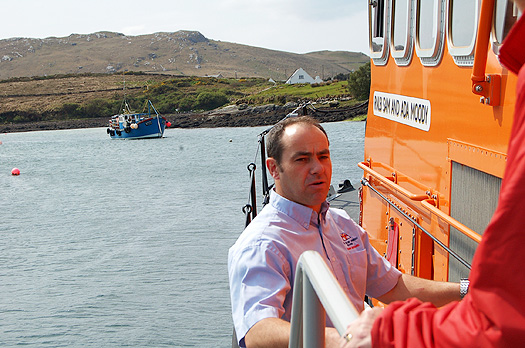
Stephen McNulty, Achill lifeboat mechanic
"There are two boat hooks on the lifeboat. The starboard one is blue and the port is white and they are the only items on the modern boat which remains as a tradition from the past."
When Stephen McNulty, Achill Lifeboat's Mechanic told me that, I learned something new about maritime tradition. I love visiting lifeboat stations. They are very special places with a strong sense of community spirit, the foundation base for the lifeboat service. I was being shown around the Achill Trent class boat, Sam and Ada Moody, on the pontoon at Cloghmore in Achill Sound, an area of magnificent coastal scenery with the highest cliffs in Ireland. Achill lifeboat crews have received eight awards for gallantry.

Achill lifeboat - white pole on port side
"I saw you looking at the boat hooks and thought you mightn't know their background," Stephen McNulty chuckled as he saw me looking more closely at them and wondering why I hadn't noticed them before on other boats!
"Traditionally on the old rowing lifeboats, when the boats were wood and the men were steel, the oars were blue on the starboard and white on the port side," he said. "It continues the tradition in the way we have them aboard today and they remind us of what those in the past did for the saving of life and the challenges they faced."
67 CHILDREN DROWN IN 10 YEARS
The Irish Water Safety Association has drawn attention to the start of summer holidays for primary school children in a few weeks, "many of whom may lack an awareness of how to stay safe when playing near or on the water."
John Leech, CEO of the Association and a former Naval Service Officer, is a man I have known for many years whose dedication to the concept of safety on the water has driven awareness of wearing lifejackets on leisure craft and urging fishermen to wear personal buoyancy at sea.
"Sixty-seven children aged fourteen and under drowned in Ireland in the last ten years. Responsible parental supervision guarantees child safety yet tragic drownings occur every year when children escape the watchful eye of guardians."
The Water Safety Association's "PAWS" programme (Primary Aquatics Water Safety) is a component of the primary school curriculum teaching children how to stay safe around water.
TRADITIONAL BOATS
The beauty of traditional boats was evident in Cork Harbour when the beautiful craft pictured here sailed past while I was on the water on Bank Holiday Monday. Many more traditional craft will be on the harbour waters next weekend, June 15, 16, 17 when the annual Crosshaven Traditional Sail is held, organised by a local committee in association with Crosshaven Vintners. It is always a great weekend to meet and talk with the owners of traditional boats who are so outgoing with information about their boats, conveying the pride and dedication which are an essential ability of the owners of traditional craft.
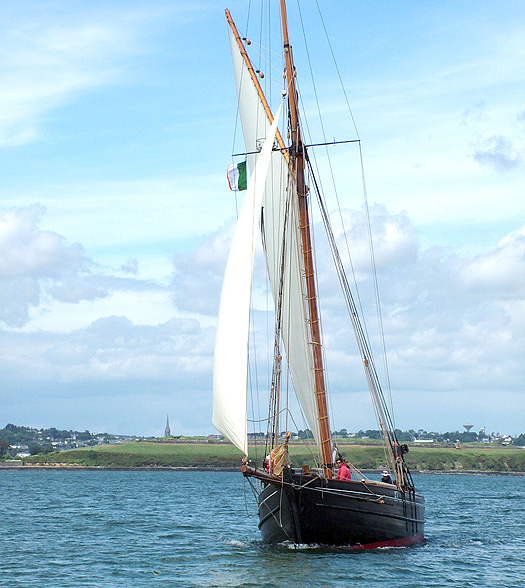
The beauty of traditional boats in Cork Harbour
Pat Tanner is the event Co-ordinator with the experienced sailor, Dave Hennessy, as Officer of the Day. Boats can register on arrival at Crosshaven Pier. For everyone who turns up, afloat and ashore, adults and children, they are running a "Mad Fish Headgear Competition" – 'Let everything nautical go to your head.'
ASTONISHING ARCTIC DISCOVERY
Scientists from Stanford's School of Earth Sciences in the USA have reported the discovery of a massive bloom of phytoplankton beneath the ice of the Chukchi Sea in the Arctic, which they say challenges long-held assumptions about the Arctic's ecology. The scientists from Stanford's School of Earth Sciences in the USA were researching aboard a Coast Guard icebreaker 200 miles west of the Alaskan coast. It seems the phytoplankton, seen for an estimated 60 miles, are thriving because the Arctic sea ice has been thinning for years, a result of global climate change. Phytoplankton are the crucial diet for many marine organisms. They make up the base of the entire Arctic food chain, supporting fish, walrus, seabirds and more. The ice was between two-and-a-half and four feet thick where the phytoplankton cells were growing and at least four times greater than in open water.
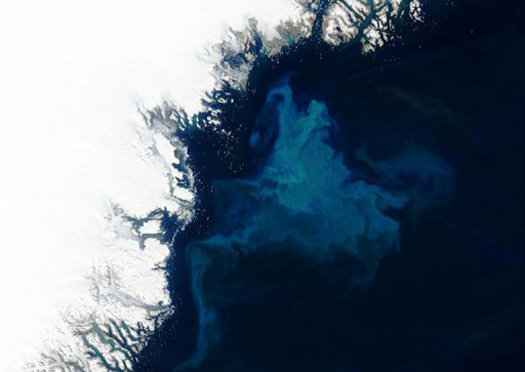
This NASA Aqua satellite image from 2003 shows clouds of phytoplankton off of Greenland's eastern coast (AFP/NASA/File)
To Email your comments to THIS ISLAND NATION: [email protected]
Follow Tom MacSweeney on Twitter @TomMacSweeney and on Facebook
Tom MacSweeney's Maritime 'Island Nation' Column
#MARITIME – From Friday, May 4 I will be writing a new weekly page for the Afoat.ie website, covering the maritime sphere in its widest application – marine, shipping, fishing, leisure, research and development.
This will be accompanied by a monthly newsletter which will be circulated to readers of Afloat.ie.
Sign-up detais will issue on May 4.
We have further plans for development of maritime coverage through the Afloat.ie website, providing the widest coverage of the marine sphere.
I look forward to your interest in this new approach and you can also follow this coverage on Afloat Twitter and Facebook and on Twitter @TomMacSweeney and on my Facebook page.
Sailing Clubs Must Support Struggling Members
Last month AIB pulled the plug on sailing club fees for staff. Next month the Irish Sailing Association aims to rejig the annual fee it charges to clubs at an egm. They are signs that the necklace of over 70 yacht clubs around the coast and on inland waters are under financial pressure. No wonder as the cost of going sailing, as well as many other sports in Ireland, proves too much to bear for many families.
In his recent column (below) in the Evening Echo Marine Correspondent Tom MacSweeney highlighted the need for Sailing Clubs around the coast to do all they can to help struggling memberships.
Membership is becoming an issue for sailing clubs to judge from what club officers around the coast have been telling me. It is a sign of the economic times. Families and individuals have to examine closely what to do with the money they have left after the government has raided their incomes.
I have been told that club members and particularly those holding family memberships are looking at how much they pay for an inclusive membership and reducing it to just one individual membership. Others have told me that they are faced with deferring payments or foregoing membership altogether.
Clubs are responding to the situation in different ways.
While the more realistic are taking steps to deal with the issue, there are indications that others are ignoring a situation that, it appears, could affect the popularity of the sport. This may be from an entrenched position or snobbish attitude where they don't want to admit difficulties in public. An inadvisable situation when income is being squeezed and the future challenged.
Payment systems such as monthly standing orders, direct debits, concessions for early payments, have been introduced by those clubs realistically dealing with the situation. Sailing is not the only sporting activity being affected, I hear of golf, rugby, soccer and other clubs feeling the pinch of reduced incomes, soaring taxes and charges levied on household incomes by the government. Something has to give because there is a limit to the amount of money people have. Government politicians seem incapable of understanding that people have not got enough money or sufficient disposable incomes because of the State raping their salaries.
Another aspect of the impact of deteriorating income levels appears to be the demand for marina spaces, with boat owners not as active as they had been in seeking berths and telling me frankly they cannot stretch incomes to afford prices during high season. Some boatyards are feeling the effects also around the country, as are yacht sales. A lot of boats are for sale and replacement plans by sailors who had planned to upgrade have been put on hold.
The oldest yacht club in the world, the Royal Cork at Crosshaven, has been responding to the challenging times. Last season it introduced a monthly membership scheme and a crew membership system as an innovative response to the challenge which the sport faces.
When he took over as the club's new Admiral at its annual general meeting last Monday night in the Crosshaven clubhouse, Peter Deasy acted immediately, announcing that the club would take further steps to address the issue.
He has taken office for a two-year period in succession to Paddy McGlade, a post which follows his successful leadership of the last Cork Week two years ago when he was Chairman. Cork Week will be held again this year, from July 7 to 13.
"There is a membership challenge, it is one facing all clubs in these times and it will be addressed by this club," he said. He stressed the importance of encouraging more people into sailing. The club is to carry out a review of its membership system, amongst other steps. On Monday night members approved an increase in subscription levels for those over 65, who pay a reduced rate as 'seniors,' as is the situation in many clubs.
The RCYC is taking a realistic, determined approach toward what is an issue born of these difficult national economic times. Peter Deasy also emphasised the importance of encouraging young sailors and keeping them within the sport.
This is a topic I have addressed before. Not every young sailor will reach the top competitively, but all are needed to remain in the sport in this island nation. When they emerge from dinghies there is a difficulty, experienced in many clubs around the coast, of maintaining their involvement.
Powerboat Racing's 'America's Cup' Returns to Cork
Plans are afoot to bring powerboat racing's Harmsworth Trophy event to Cork in 2014 - over 100 years since Cork Harbour hosted the first ever edition of the race. SCROLL DOWN FOR ARCHIVE Footage.
Regarded as the powerboat version of yachting's America's Cup, the first Harmsworth Trophy was won in July 1903 by Napier, which was allegedly piloted by women's world land speed record holder Dorothy Lewitt.
According to the Tom MacSweeney column in the Evening Echo, a consortium is hard at work to bring the race back to its birthplace - coinciding with the Round Ireland Powerboat Race, which will also be held out of Cork in 2014.
Denis Dillon of the Irish Sailing Association commented: "There is a group of Cork enthusiasts interested and is trying to put a consortium together that would also bring back one of the original 1903 boats still is existance which is in the USA.
"It came first in its class and second overall in the race in 1903 and they hope to bring it back for the 2014 race."





























